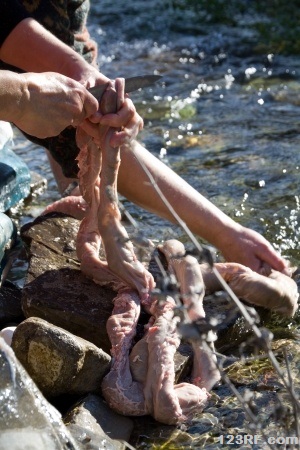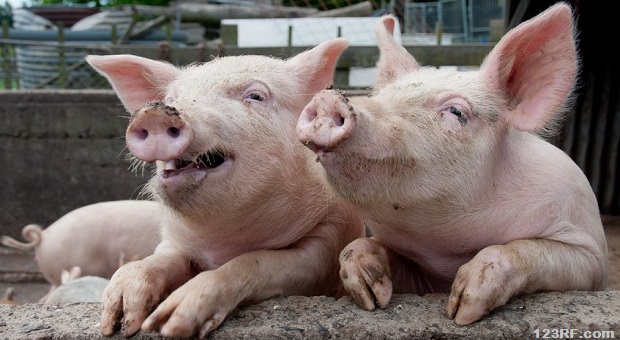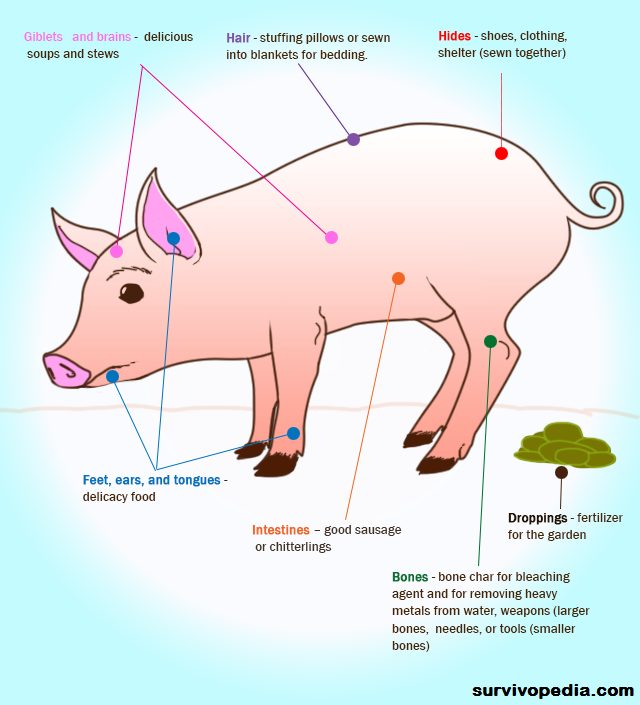When it comes to raising pigs for commercial purposes, there is a joke in the industry that everything is used but the squeal. If you are looking for a multi-purpose animal for survival purposes, pigs are ideal. Aside from getting meat from pigs, just about everything else can be used to bolster your chances of survival.
Miniature Pigs vs. Standard Pigs
During the initial days of a social collapse, you are bound to be on the run or stuck indoors. Unless you have several acres of land, it may not be possible to have full sized pigs and ensure their safety. On the other hand, miniature pigs are growing in numbers as household pets.
You can easily transport them by car and keep them indoors until rioters or other criminals leave the area. While you may not get as much meat or other resources from miniature pigs, you can always build your herd up so that you have enough to live on.
It is also important to realize that full sized pigs require more water and food. Even if you keep larger pigs at a well fortified bug out location, it may not be possible to take care of them all.
For example, in the event of a nuclear attack or other disaster that makes water and food unfit for consumption, you will not have enough resources to care for full sized pigs. That said, if you can purify enough water and scrape together enough food to feed a person, you can also take care of miniature pigs.
Raising Pigs
Pigs make ideal farm animals in the sense that they will eat almost anything and require relatively little care. You can keep full sized pigs in a pen as long as they have access to plenty of water, mud, and grass. Since pigs are also cheaper to buy than many other farm animals, it will be a bit easier to get started with them.
Even though pigs tend to be resistant to the kinds of diseases that would wipe out a herd of cattle or a flock of avians, they still have their illnesses to watch out for. This includes E.coli and other bacterial infections. Since pig skin is actually very sensitive, you should always keep an eye out for dermatitis. Even a slight cut on a pig’s skin can lead to a serious infection.
Slaughtering and Butchering Pigs
Unlike avians and cows, you cannot get much other than manure and good company from pigs without slaughtering them. If you have never hunted or killed an animal for food, then you may have a very hard time with this aspect of keeping pigs.
Before you decide to keep pigs, take the time to study slaughter methods and take note of how you feel about each method. If the methods you find seem inhumane, keep looking until you find something you can deal with that will not lead to contaminated flesh or serious injury to yourself or others.
When it comes right down to it, slaughtering and butchering any animal, including pigs is not something you can learn and master from studying a book, article or video, and then try to experiment with on your own. Here are some important points to consider about mastering pig slaughter:
- There is a huge difference between reading or watching videos on pig slaughter and actually dealing with an animal that will fight to the death for its life.
- When you take the life of an animal, make sure you will not waste any part of the body. This is a matter of respect for the animal’s life as much as it is common sense for survival needs.
- If you make a mistake or get wrong information about slaughter methods, you can get injured or killed.
- If you don’t have the right equipment, you may contaminate the meat or cause other problems.
- Inability to treat cuts and scrapes that may be contaminated with pig blood and flesh can open you to all kinds of disease, as can improper handling of the carcass.
Once you become acquainted with slaughter methods, find a pig farmer that will supervise your first kill and the butchering process. This learning and apprentice period is essential for helping you to determine whether or not you can slaughter and butcher pigs on a regular basis, as well as help you learn the safest way to carry out these tasks.
Quite frankly, if you cannot slaughter pigs respectfully and use all the parts responsibly, you are better served by looking to other means of meeting survival needs.
Pig Parts and How to Use/Store Them
Aside from using the muscle for pork chops and bacon, pork can be made into jerky for long term storage.
You can also make salted hams and other forms of preserved meat that will last months in cold storage.
Here are some
- Pig intestines can be used for making sausage or chitterlings
- Pig giblets and brains make good soups and stews
- Pig bones can be burnt to make bone char, which can be used as a bleaching agent and remove heavy metals from water.
- Larger bones can be sharpened and shaped to make weapons.
- Smaller bones can be used for needles and other small tools.
- Hair can be used for stuffing pillows or sewn into blankets for bedding.
- Pig hides are very resilient when properly stretched and tanned. They can be used for shoes, clothing, and sewn together to make a shelter.
- Pigs feet, ears, and tongues can also be consumed, and are considered a delicacy in some parts of the world.
- Pig droppings are ideal for making fertilizer for the garden, as are any parts that you do not use for food or other purposes.
There is no question that many survival needs can be met by keeping pigs. On the other hand, if you cannot slaughter these animals for meat and other needs, you will not be able to use your resources effectively. Rather than wait for disaster to strike, now is the time to be honest with yourself and take steps to work with a pig farmer to learn what you need to know about every phase and stage of pig keeping.
Find out more about this other amazing food source in Pocket Farm.
This article has been written by Carmela Tyrell for Survivopedia.









Pingback:To Relocate To The Country Or Not? 7 Questions Answered | Survival skills, survival guns, survival guide | April 27, 2015
|
Pingback:Back To Basics: How To Make And Preserve Lard | Prepper's Survival Homestead | March 23, 2016
|
Pingback:Back To Basics: How To Make And Preserve Lard | Survivopedia | March 23, 2016
|
Pingback:What You Don’t Know About Raising Pigs For Survival | Prepper's Survival Homestead | March 31, 2016
|
Pingback:To Relocate To The Country Or Not? 7 Q&A – The Prepper Dome | April 14, 2016
|
Pingback:» To Relocate To The Country Or Not? 7 Q&A - Prepper Ways | April 14, 2016
|